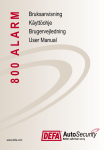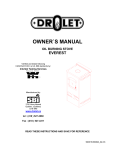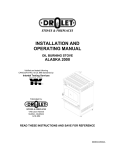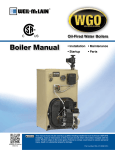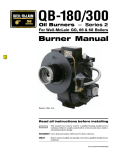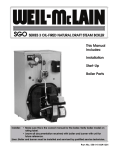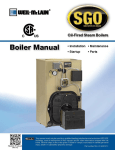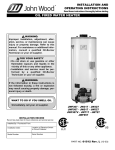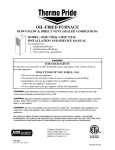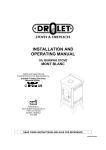Download Drolet GRIZZLY Technical data
Transcript
INSTALLATION AND OPERATION MANUAL OILBURNING FIREPLACE INSERT GRIZZLY Verified and tested following CAN/CSA B140.3 and UL 896 standards by: Intertek Testing Services Fabricated by: 1700 Léon-Harmel Québec, (Québec) G1N 4R9 READ THESE INSTRUCTIONS AND SAVE FOR REFERENCE. 990826/45080A TABLE OF CONTENTS Table of illustrations ................................................................................................................................................ 1 Presentation of your grizzly fireplace ...................................................................................................................... 2 Technical data ......................................................................................................................................................... 2 Installation instructions ............................................................................................................................................ 3 Installation procedure.......................................................................................................................................... 3 Locating the fireplace.......................................................................................................................................... 3 Clearances .......................................................................................................................................................... 4 Fireplace assembly ............................................................................................................................................. 5 Leveling the fireplace .......................................................................................................................................... 7 Chimney installation............................................................................................................................................ 8 Connecting fireplace to oil tank......................................................................................................................... 10 Preliminary test ................................................................................................................................................. 11 Adjustment of the draught................................................................................................................................. 11 Inserting the fireplace........................................................................................................................................ 13 Facing ............................................................................................................................................................... 14 Operation instructions ........................................................................................................................................... 16 Combustible ...................................................................................................................................................... 16 Lighting.............................................................................................................................................................. 16 Changing intensity ............................................................................................................................................ 17 Turning the stove off ......................................................................................................................................... 17 Maintenance .......................................................................................................................................................... 18 Troubleshooting guide........................................................................................................................................... 19 Spare parts ............................................................................................................................................................ 21 W a r r a n t y ......................................................................................................................................................... 23 TABLE OF ILLUSTRATIONS Figure 1 : Figure 2 : Figure 3 : Figure 4 : Figure 5 : Figure 6 : Figure 7 : Figure 8 : Figure 9 : Figure 10 : Figure 11 : Figure 12 : Figure 13 : Figure 14 : Figure 15 : Figure 16 : Figure 17 : Figure 18 : Figure 19 : Figure 20 : Figure 21 : Figure 22 : Figure 23 : Figure 24 : Figure 25 : Figure 26 : Figure 27 : Grizzly fireplace insert ....................................................................................................................... 2 Corner installation.............................................................................................................................. 3 Wall installation.................................................................................................................................. 3 Minimum clearances to combustible materials.................................................................................. 4 Carburetor assembly ......................................................................................................................... 5 Hook up of the copper oil supply pipe ............................................................................................... 5 Insulating wool installation................................................................................................................. 5 Top spacer supports installation........................................................................................................ 5 Sides and back spacers installation .................................................................................................. 6 Fan electric connections.................................................................................................................... 6 Levelling the burner ........................................................................................................................... 7 Direct installation ............................................................................................................................... 8 Inside deviation installation................................................................................................................ 8 Exterior deviation installation............................................................................................................. 8 Minimum chimney height................................................................................................................... 9 Chimney clearances. ......................................................................................................................... 9 Fireplace and oil tank connection .................................................................................................... 10 Draught test ..................................................................................................................................... 11 Draught Regulator ........................................................................................................................... 12 Regulator adjustment ...................................................................................................................... 12 Clearances to combustible materials .............................................................................................. 13 Fireplace facing ............................................................................................................................... 15 Burner, ring and catalyst.................................................................................................................. 16 Constant level flow control valve (carburetor) ................................................................................. 16 Arming / dearming flow control valve (carburetor)........................................................................... 16 Cleaning tee..................................................................................................................................... 18 Grizzly exploded view, spare parts list ............................................................................................ 22 Page 1 of 23 PRESENTATION OF YOUR GRIZZLY FIREPLACE Components: 1. 2. 3. 4. 5. 6. 7. 8. 9. 10. 11. 12. 13. 14. Anchor plate adaptor; Burst disc plate; Blue flame burner; Louvers; Oil valve (Carburetor); Flow regulation button; Fan rheostat; Oil pan; Structure; Adjustable legs; Spacer support; Facing surround; Combustion chamber; Flue outlet. Plate Figure 1 : Grizzly fireplace insert TECHNICAL DATA GRIZZLY OIL FIREPLACE Output heating capacity: Minimum: Maximum: Flow rate : Minimum: Maximum: Minimum draught required: NO 1 OIL kW BTU/h 2,2 7 350 4,4 15 100 cc/min litre/h 6,0 0,36 12,0 0,72 0,06 INWC CLEARANCES TO COMBUSTIBLES mm in Back 50 2 Sides 100 4 Top 1220 48 note 1 note 2 255 10 Mantel shelf NO 2 OIL kW BTU/h 1,6 5 550 3,7 12 700 cc/min litre/h 4,5 0,27 10,0 0,60 0,06 INWC DIMENSIONS Note 1 : maximum depth allowed : 8 in. Note 2 : 10 in above facing. A MINIMUM CLEARANCE OF 2 in (50 mm) BETWEEN (A TYPE) CHIMNEY AND COMBUSTIBLE MATERIALS HAS TO BE RESPECTED. Height : Width : Depth : Ø of flue : Ø of burner : mm 825 740 480 130 180 in 32 29 19 ½ 5 7 Glass ( 3 ) : Weight : 144 x 264 91 kg 6 ½’’ x 12’’ 200 lbs Page 2 of 23 INSTALLATION INSTRUCTIONS Here are the steps to follow while installing your new oil burning fireplace. Pay special attention to the instructions proposed to you such as clearances. In following the instructions of this manual, you will be assured of a simple and secure installation. INSTALLATION IN Canada HAS TO BE IN ACCORDANCE WITH CAN/CSA B-139 : STANDARDS INSTALLATION CODE FOR OIL-BURNING EQUIPMENT. IN THE U.S. THE NFPA 31 STANDARD NATIONAL FIRE PROTECTION ASSOCIATION STANDARD FOR OIL-BURNING EQUIPMENT IS TO APPLY. The installation shall be made by a qualified person member of the corporation in force in your area. Installation Procedure 1. Locating the fireplace; 6. Connect the oil line; 2. Respect clearances; 7. Preliminary test; 3. Fireplace assembly; 8. Inserting the fireplace; 4. Level the fireplace; 9. Framing the fireplace. 5. Chimney installation; Locating the fireplace Some advices : • • • Choose the room where the installation will benefit everyone; Favour a central area so that the heat will spread-out evenly in your home; Chimney installation should be as straight as possible. Many configurations are possible, the most frequent ones are illustrated bellow. (Figure 2 and 3) Figure 2 : Corner installation Figure 3 : Wall installation Page 3 of 23 Clearances Refer to technical data of your fireplace on page 2, in order to know its technical and physical characteristics. Respect required clearances to combustible materials while installing your fireplace. These clearances have been verified and approved according to CAN/CSA B 140.3 and UL 896 standards. • Also respect required clearances of the (A Type) chimney that you are installing; • For this, see your local dealer to know what are the clearance specifications of the chimney manufacturer that you are using; • Don’t forget that the wooden parts of the frame have to be 2 inches or more from the factory built chimney; • The opening in the frame should be 36 3/4’’ in width by 35 3/4’’ in height. Following are the clearances to combustible materials: 2’’ Back of fireplace; 4’’ Sides of fireplace; 48’’ Above fireplace. Figure 4 : Minimum clearances to combustible materials Page 4 of 23 Fireplace Assembly For the assembly of your fireplace, you have received with this manual, all the hardware that you need. See bellow, the list of what should be included. 16 screws no 8 x 5/8’’ to fix spacer supports (stand off); 2 bolts ¼ -20 x ¾’’ to assemble carburetor support on the right side of structure; 2 spacers of 2’’ for the back of the structure; 2 spacers of 4’’ for the sides of the structure; 2 spacer supports of 8’’ for the top of the structure; 3 wire connecters for the assembly of fan rheostat to 110 Volts inlet wire; Carburetor oil pan. Carburetor Install the flow-regulating valve on the right side of the structure. Fasten the valve support plate with the bolts provided for this purpose. (Figure 5). Figure 5 : Carburetor assembly Oil supply pipe The copper oil supply pipe has to be hooked up between the valve’s outlet and the burner’s inlet. Use an 7/16’’ key. (Figure 6). Figure 6 : Hook up of the copper oil supply pipe Insulating wool Top spacer supports • Remove the chimney trap; • Install the anchor plate and the first section of (A type) factory built chimney of the brand of your choice; • The insulating wool has to be placed on top of the structure. The top should be completely covered. The supports have to be screwed into the drilled holes (4 each side) on top of the fireplace structure. Figure 7 : Insulating wool installation Figure 8 : Top spacer supports installation In order to easily locate the holes under the wool blanket, use a 2’’ finishing nail to find holes. Page 5 of 23 Fireplace assembly (cont’d) Sides and back spacers Use the drilled holes on each side and at the back of the fireplace structure to align and screw into place the spacers; The sides spacers provides a 4’’ clearance; (1 each side) The back spacers provides a clearance. 2’’ Figure 9 : Sides and back spacers installation Fan rheostat The fan rheostat has to be connected to a 110 VAC electric source; Run the 14 GA wire through the square opening located at the back of the structure; Connect ground wire to the electrical box. Figure 10 : Fan electric connections Page 6 of 23 Leveling the fireplace Figure 11 : Levelling the burner • Now that your fireplace is installed into place, you have to level the burner. • Put the level in the middle of the burner parallel to the door. (See figure 11-a). Screw or unscrew the adjustable legs until perfect level has been reached. Use a 7/16’’ (10 mm) key. • Then put the level in the middle of the burner so that it is parallel to the sides (See figure 11-b). Screw or unscrew the adjustable legs until perfect level has been reached. Use a 7/16’’ (10 mm) key. IMPORTANT : IT IS VERY IMPORTANT TO LEVEL THE BURNER TO ALLOW A PROPER OIL VAPOR DISTRIBUTION THROUGHT THE RING AND THE CATALYTIC CONVERTER. Page 7 of 23 Chimney installation • ONLY (‘’A’’ TYPE) FACTORY BUILT CHIMNEY CAN BE USED for the installation of your GRIZZLY fireplace. Use only 30 O or 45O elbows. NO 90O ELBOWS ARE ALLOWED. • The use of BLACK PIPE CONNECTORS (SINGLE OR DOUBLE WALL PIPES) IS STRICTLY PROHIBITED. • Many configurations are possible, the most frequent ones are illustrated in figures 12, 13, and 14. • Respect clearances indicated in table 1. These clearances have been tested and verified in the course of certification and homologation sessions. Also respect factory built chimney required clearances. See your dealer to know the specifications of the chimney manufacturer. Figure 12 : Direct installation Figure 13 : Inside deviation installation • NOTE: It is essential to ensure yourself that the room where the fireplace is located sufficiently ventilated to provide an adequate air supply. • If your home is well insulated, it is possible that you will have to install an fresh air intake directly from outside and routed to the unit. • Drolet Stoves & Fireplaces do not recommend that you connect a factory built chimney to a masonry chimney. Figure 14 : Exterior deviation installation THE BURNING OF ONE LITRE OF FUEL (OIL) REQUIRES APPROXIMATLY 30 m3 OF AIR AND WILL PRODUCE ABOUT 0,8 kg OF WATER VAPOR AND 9 m3 OF CARBONE DIOXIDE AND ATMOSPHERIC NITROGEN. A SOURCE OF AIR FROM THE OUTSIDE IS NEEDED TO REPLACE COMBUSTION AIR. Page 8 of 23 Chimney installation (cont’d) • DROLET STOVES & FIREPLACES requires the use of an (A TYPE) factory built chimney having a constant 5’’diameter. Using a larger flue tends to make combustion gas expand and cools them off witch have for result of lowering the draught effects. Gas expansion reduces the speed of the draught and have the same effects. • Low gas temperature will tend to condense and freeze or leak in your chimney. • Refer to technical data in (table 1) in order to know the required minimum draught needed for your fireplace. Follow this specification for proper operation. • The chimney has to reach a minimum of 15’ high. It has to extend not less than 3’ above the point it exits the roof and 2’ higher than any roof, building or other obstacles within a horizontal distance of 10’. • CHIMNEY MINIMUM HEIGHT: Chimney height must not be less than 15’. (4.6 m). Figure 15 : Minimum chimney height. • CLEARANCES WITH ROOF SUMMIT AND BUILDING NEARBY : The chimney flue shall extend at least 2’ (0.6m) above the highest roof surface or structure within 10’ (3 m) horizontally of the chimney. Figure 16 : Chimney clearances. • CLEARANCE FROM ROOFING INTERSECTION : The chimney flue shall extend at least 3’ (0,9 m) above the highest point at witch it comes in contact with the roof. YOUR APPLIANCE SHALL BE CONNECTED TO A CHIMNEY HAVING SUFFICIENT DRAUGHT AT ALL TIME TO ASSURE SAFE AND PROPER OPERATION OF THE BURNER. Page 9 of 23 Connecting fireplace to oil tank • Make sure that the tank outlet is 12" (305 mm) higher than the inlet of the carburetor. (Gravity fed) • Use only copper piping to connect tank to stove. • Make sure that there is a small slope on the connection from the tank toward the stove. • A 3" (75 mm) down slope is needed on the tank itself, from the outlet towards the other end of the tank. • When the tank is installed outdoors, it is preferable to use oil #1, to avoid viscosity problems. NOTE : THE BAROMETRIC TANK SHALL BE LOCATED SO THAT THE TANK WILL NOT BE EXPOSED TO THE DIRECT RAYS OF THE SUN OR BE ADJACENT TO ANY SOURCE OF INTENSE HEAT. Figure 17 : Fireplace and oil tank connection Page 10 of 23 Preliminary test Before inserting the fireplace, it is suggested to verify the items listed below and correct if necessary; • • • • • Leaks on copper connections; inlet and outlet of the valve as well as the inlet of the burner; The chimney is properly in place and well secured with approved parts; The burner has been levelled; The fireplace is permanently attached to hearth; Enough draught is available and has been adjusted according to the following procedures. Adjustment of the draught • Your stove operates with natural draught, created by the ascension of combustion gases in the chimney. This movement creates a siphon effect in the stove and forces ambient air to go in the burner by the holes in its surround. These orifices let air in for combustion. • For the unit to function properly, it is essential to check the quality of the draught using a draught gauge. The draught is usually measured in inches of water column. • Check the minimum draught required of the unit on page 1. The draught mentioned has to be reached rapidly at a minimum settling (position #1). • Depending on the model, the draught can be taken by the orifice on the cooking surface. The measure can also be taken by the orifice on the draught regulator usually plugged by a rubber cap. The orifice on the cooking surface is still the best area. IMPORTANT : ALWAYS MEASURE THE DRAUGHT WITH ALL VENTILATION EQUIPMENT INSTALLED IN THE HOUSE (RANGE HOOD, BATHROOM FAN, AIR EXCHANGER, DRYER, ETC IN OPERATION.) ref. : standard CAN/CSA B-139 art. 4.1.5. Measuring the draught : • For a proper operation of the fireplace, it is essential to check the chimney draught with a draught gauge. Since natural draught is low, inches or millimetres of Water Column are used for the draught measurements. • Chimney’s minimum draught required is 0,06’’ of W.C. Draught should be reached rapidly at the minimum flow setting, (position «1»). • Measure the draught by using the hole made in the burst disc plate designed for this purpose. (see figure 18). Figure 18 : Page 11 of 23 Draught test Preliminary Test (cont’d) Draught regulator : • An excessive draught is as bad as a draught to low. • The regulator controls the draught when it is excessive (in high winds for example). • If the draught exceeds 0.08 in of water column, you will have to adjust the regulator Figure 19 : Draught Regulator Adjusting the draught : • To adjust the draught you have to screw or unscrew the court weight on the regulator. Regulator open lowers the draught regulator closed increases the draught. Figure 20 : Regulator adjustment THE ONLY RIGHT WAY OF MEASURING THE DRAUGHT IS TO USE A DRAUGHT GAUGE THAT GIVES READING IN INCHES OF WATER COLUMN. ALL OTHER METHOD (CANDLE, MATCHES, ETC.) ARE UNRELIABLE. INSTALLATION OF YOUR STOVE HAS TO BE IN ACCORDANCE WITH CAN/CSA B-139 INSTALLATION CODE FOR OIL-BURNING EQUIPMENT IN CANADA AND STANDARD NFPA 31 NATIONAL FIRE PROTECTION ASSOCIATION STANDARD FOR OIL-BURNING EQUIPMENT IN THE U.S.. NOTE : THE INSTALLATION SHALL BE MADE BY A QUALIFIED PERSON MEMBER OF THE CORPORATION IN FORCE IN YOUR AREA. Page 12 of 23 Inserting the Fireplace Now that the unit is in place, the burner is levelled and all previous verifications are made. It is time to build the surrounding frame and walls. Always respect minimum clearances between, the fireplace as well as the factory built chimney, and combustible materials. Legend, figure 21 1. 2. 3. 4. 5. Figure 21 : Clearances to combustible materials Page 13 of 23 Gyps wall; Shelf; Facing; Wooden frame; Spacer support Facing 1. Assemble the (3) parts of the facing using the (4) nuts and bolts received in the hardware package. 2. Place the assembled facing on the front part of the fireplace : Align bottom of the facing with the bottom of the fireplace structure; Align the flow regulating rod with the hole on the right side of the facing; Insert the inner edges of the facing in the clips located on the outside of the combustion chamber. Page 14 of 23 Facing (cont’d) 3. Push the facing towards the structure of the fireplace. (Push in aligned with clips). Install the control knob on the flow regulating rod. NOTE : The facing must lean evenly on the fireplace structure and finished front wall. 4. Hook up the top and bottom louvers: The top louver sits on (4) hooks. The bottom louver slides in (2) pins. The bottom louver is used as an access panel. Tip it towards you to have access to the fan rheostat, cleaning tee and the carburetor (valve). 5. Install the small polished brass handle using (1) bolt and (1) nut provided in the hardware package. Figure 22 : Fireplace facing Page 15 of 23 OPERATION INSTRUCTIONS Combustible • Your stove has been designed to work with oil #1 or #2. DO NOT USE GASOLINE, CRANKCASE OIL OR ANY OIL CONTAINING GASOLINE. Drolet Stoves & Fireplaces declines all responsibility regarding damage cause by using other combustibles. • Make sure to use oil without impurities which may plug filters and valve’s orifice. Impurities only give an improper combustion. Lighting BEFORE LIGHTING • make sure that : The tank is full; The isolating valve is open; • See that the ring is in the right position.(figure 23). • Make sure that the flow regulating handle is in the « 0 » position (figure 24). • If it’s not already done, arm down the valve’s lever located behind the stove (figure 25). • Wait for the valve to fill up and let the level stabilize. BEFORE ATTEMPTING TO LIGHT YOUR STOVE, MAKE SURE THAT THE FLOW REGULATING HANDLE IS IN THE 0 POSITION. Figure 23 : Figure 24 : Constant level flow control valve (carburetor) Figure 25 : Arming / dearming flow control valve (carburetor).. ATTENTION: Burner, ring and catalyst DUE TO HIGH SURFACE TEMPERATURE, KEEP CHILDREN, CLOTHING AND FURNITURE AWAY Page 16 of 23 Lighting (cont’d) • Place the flow regulating handle on the "1" position, as soon as the oil enters the burner return to "0" position. • Open the door and pore into the burner 2 to 3 once (75 ml) of lighting gel or wood alcohol. NOTE : USE OF LIGHTING GEL IS BETTER OF A SAFE IGNITION. • With a long wood match, ignite carefully and close the door. • After a couple of minutes (before alcohol goes out) the burner and the chimney are hot, place the flow regulator handle on "1" position. Note : Do not leave matches or other materials in the burner in order to keep it clean. It allows a better combustion. IF YOU MISS THE STOVE’S LIGHTING, ALWAYS WAIT FOR THE BURNER TO COOL DOWN TO ROOM TEMPERATURE BEFORE USING BURNING ALCOHOL AGAIN. IF, FURTHER TO SOME MISOPERATION, THE BURNER IS FILLED WITH IMPORTANT QUANTITIES OF OIL, ALL OF THE OIL MUST FIRST BE REMOVED BEFORE LIGHTING THE STOVE AGAIN. Changing intensity • Always wait 10 minutes minimum before increasing the flow (between each position). This allows flamme to stabilize and avoid suiting up. • No waiting is needed to decrease the flow. Turning the stove off • Set the flow regulating handle to position ‘’0’’. • If you plan to keep the stove off for a long while, it is recommended to disarm the valve’s lever and close the tap on the pipe between the stove and your oil tank. ALWAYS KEEP THE VALVE SHUT OFF WHEN THE BURNER IS NOT OPERATING Page 17 of 23 MAINTENANCE ONCE A WEEK : • Clean the oil inlet tube of the burner with the cleaning tee : Push in the rod of the cleaning tee while turning it; move back and forth operation 2 or 3 times; Pull it back into place to finish the operation. Figure 26 : Cleaning tee WHEN YOUR STOVE IS RUNNING, ALWAYS KEEP THE CLEANING TEE LEVER PULLED BACK INTO PLACE. ONCE A MONTH OR TWO : • Clean with a metallic brush : • The burner’s shell; • The burner’s rings; • The burner’s catalyst (in blue flame model). AT THE BEGINNING OF EACH HEATING SEASON : • Clean the valve and tank filters; • Inspect the smoke box through the opening of the rear flue outlet; • Clean the chimney and flue pipe. MAKE SURE THAT ALL HAND VALVES ARE CLOSED BEFORE CLEANING PROCEDURES. WHEN NEEDED : • Clean the glass door; • The glasses have to be cleaned only when the stove is cold. Use commercial product for this purpose, or a water and vinegar solution. Page 18 of 23 TROUBLESHOOTING GUIDE PROBLEMS CAUSES SOLUTION ON POSITION 6 (MAXIMUM) THE FLAME IS LONG AND SMOKY, THERE IS SUIT BUILD UPON THE GLASS. Position 6 was reached too quickly. 1. Set flow regulating handle to position 1; 2. wait for combustion to stabilize; 3. Progressively increase flow to desired position. NOTE : SEE LIGHTING PROCEDURES. Maximum flow is too high. 1. Set flow to a lower position; 2. Call a qualified technician to adjust the valve. Cleaning tee and/or burner are dirty. 1. Activate cleaning tee according to procedures; 2. Schedule at the next shut off to clean the burner. Orifice of plunger is partially plugged. 1. Progressively increase flow to position 6; 2. Push in many consecutive times on the thermostatic regulator bottom to remove dirt form the orifice. ON POSITION 1 (MINIMUM) THE FLAME PRODUCES SMOKE AND SUITS THE GLASS. NOTE : If the problem persist, you may have to remove and clean out the valve with alcohol. Call your specialized technician. ON POSITION 1 (MINIMUM) THE FLAME PRODUCES SMOKE AND SUITS THE GLASS. Flow is to low. Page 19 of 23 1. Slightly increase the flow regulating handle; 2. Call a specialized technician. TROUBLESHOOTING GUIDE (CONT’D) PROBLEMS THE FLAME PRODUCES SMOKE, IN ANY POSITION. FLAME GOES OUT BY ITSELF. THE STOVE MAKES NOISE, GOES OUT AND LIGHT UP AGAIN. CAUSES Door gasket properly. is not SOLUTION selling 1. Tighten door by turning counter clockwise the door handle; 2. Check if gasket needs to be changed. The burner orifices are plugged up. 1. Clean the burner with a metallic brush. Draught is too low. 1. Make it checked technician. Oil level in the tank is too low. 1. Fill up the tank. Air pocket is stocked in the oil line. 1. Call a technician to drain the line; 2. Make sure that the oil line has an adequate slope towards the tank. Oil #2 is used in exterior tank. 1. Use only oil #1 when tank is installed outside. Partial or total obstruction by impurities in oil line or filters. 1. Check filters on tank and valve; 2. Ask a technician if the cleanness of the tank and line is OK. The stove has been lit while excess of oil was in the burner. 1. Position the flow regulating handle to ‘’0’’; 2. Let the stove cool down; 3. Clean the burner if necessary. Note : Never light the stove when the burner is full of oil. Sponge the oil out before lighting. Page 20 of 23 by a SPARE PARTS After years of use, if you need to replace some parts, please contact your SUPPLIER or one of our Drolet approved DEALERS. • Give him product data as displayed in your warranty voucher or on your appliance’s name plate at the rear. Keep the warranty voucher even after its EXPIRY date. • Our dealers are in possession of all spare parts nomenclatures and technical data about our products, and will provide you with the spare parts you need and any maintenance intervention within the scope of their professional competence. NO. 1 2 3 4 5 6 7 8 9 10 11 12 13 14 15 16 17 18 19 20 21 22 23 24 25 26 27 28 29 30 31 32 33 DESCRIPTION Handle gold plated Handle rod Hinge Cast iron door Window gasket 1/16’’ x 3/8’’ Borosilicate glass plate (3) Glass moulding (lower) Glass moulding (upper) Door gasket ½’’ Louver door Louver Facing Heat deflector Cleaning tee Burner blue flame 7’’ Burning ring Catalyst Fan Fan deflector Fan support Chimney trap Valve support Pan (carburetor) Fan rheostat Rheostat front plate Rheostat 90O male outlet elbow Oil feeding line Draught regulator Burner pan Rheostat button Valve control rod assembly Valve control gear Page 21 of 23 SPARE PARTS (CONT’D) Figure 27 : Grizzly exploded view, spare parts list Page 22 of 23 WARRANTY The Drolet Stoves & Fireplaces warranty applies to the original buyer only. This warranty may not be transferred to a second person and becomes effective on the date of purchase. Proof of purchase is necessary to validate the warranty and to establish the warranty coverage period. The warranty is conditional to normal residential use of the product. Any use other than that for which the product was intended will invalidate the warranty. The warranty covers repairs and (or) parts replacement under the terms established by Drolet Stoves & Fireplaces. PRODUCT Wood (except Hunter) GAS OIL GODIN EXTERIOR FIREPLACE HUNTER FIREBOX 5 years 5 years 5 years 5 years 1 year N/A PAINT 1 year 1 year 1 year 1 year N/A N/A COMPONENT 1 year 1 year 1 year 1 year N/A N/A FIREBOX AND PAINT The warranty covers manufacturer defects and materials. COMPONENTS The following components are covered by the one-year warranty as follows: • Woodstoves : Ceramic glass, refractory bricks, gasket, blower, thermodisc and rheostat. • Gas units : Ceramic glass, valve, burner, piezo ignitor, pilot, blower and thermodisc. • Drolet Oil Stoves : Burner, burner rings, cleaning tee and electrical components. EXCLUSIONS This warranty will not cover labour costs or any costs related to damages caused by faulty installation, repairs, abusive use or wrong usage of the product, either by a contractor, a service representative or the buyer himself. All defects or damages caused by the use of parts other than Drolet Stoves & Fireplaces original parts automatically cancels the warranty. Drolet Stoves & Fireplaces cannot be held responsible of any claims whatsoever, other than the replacement of the parts themselves. How can we resolve your claims ? Drolet Stoves & Fireplaces will honour F.O.B. plant (collect) parts replacement for defective parts. Before sending back products or components to our office, you must be given an authorization number from our representative or your dealer. Page 23 of 23
























